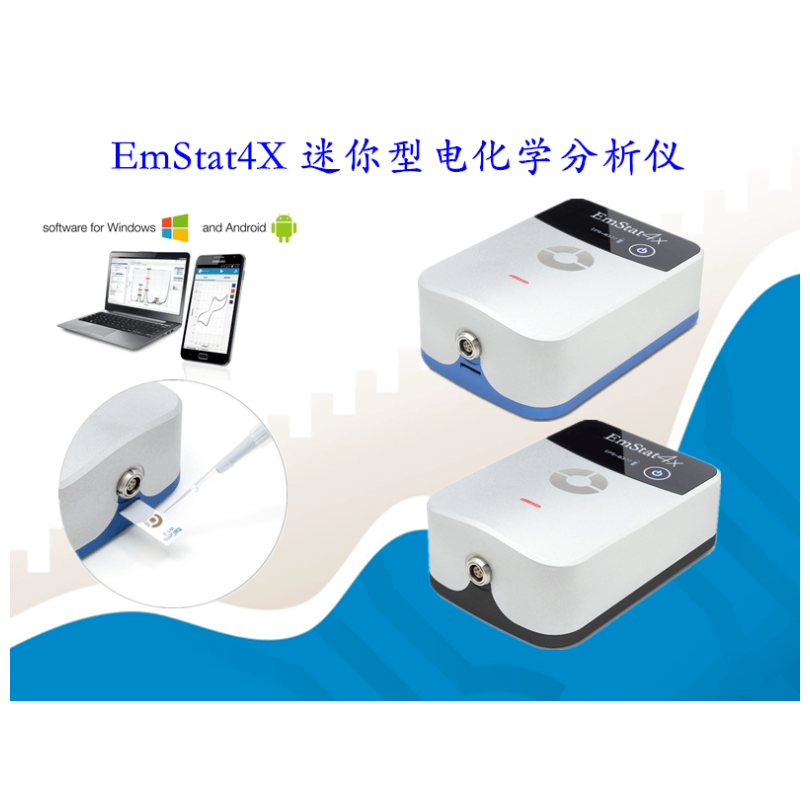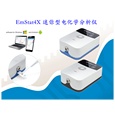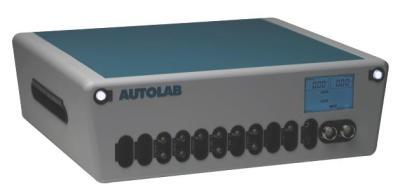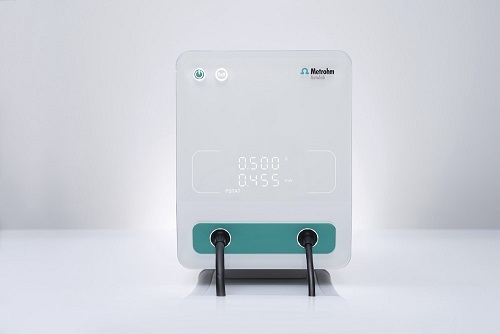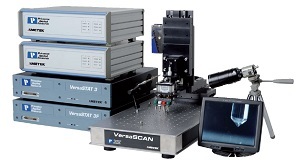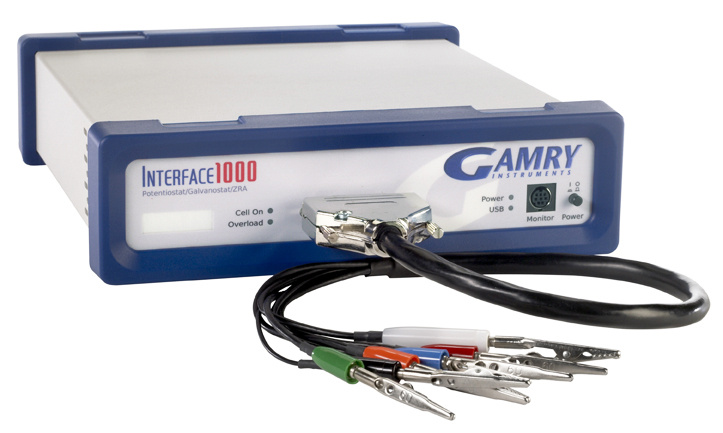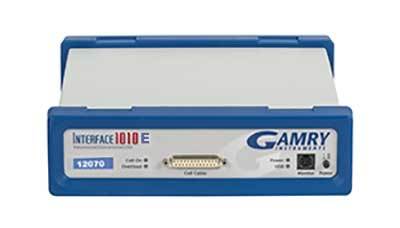方案详情
文
基于中空金纳米壳(AuNSs)修饰的一次性激光诱导多孔石墨烯(LIPG)柔性电极构建了一种低成本无线智能便携式传感器,用于磺胺类药物(SAs)的简单快速电化学检测。采用计算机控制的一步激光直写技术在聚酰亚胺基底(PI)上制备了LIPG,并通过滴涂法在LIPG电极表面修饰了AuNSs。该电极对磺胺(SN)显示出良好的电化学响应,使用传统的大型电化学工作站进行检测,线性范围为0.4 - 100 μM,最低检测限为0.035 μM,鱼和虾样品的回收率范围为96.04% - 105.00%。另外三种SAs也被检测到,它们的结果与SN相似。与采用有线传输的传统大型电化学工作站相比,采用无线蓝牙传输的便携式微型电化学工作站在磺胺类药物的食品安全现场快检方面展现出更好的可行性、实用性和优越性。
方案详情

基于中空金纳米壳(AuNSs)修饰的一次性激光诱导多孔石墨烯(LIPG)柔性电极构建了一种低成本无线智能便携式传感器,用于磺胺类药物(SAs)的简单快速电化学检测。采用计算机控制的一步激光直写技术在聚酰亚胺基底(PI)上制备了LIPG,并通过滴涂法在LIPG电极表面修饰了AuNSs。该电极对磺胺(SN)显示出良好的电化学响应,使用传统的大型电化学工作站进行检测,线性范围为0.4 - 100 μM,最低检测限为0.035 μM,鱼和虾样品的回收率范围为96.04% - 105.00%。另外三种SAs也被检测到,它们的结果与SN相似。与采用有线传输的传统大型电化学工作站相比,采用无线蓝牙传输的便携式微型电化学工作站在磺胺类药物的食品安全现场快检方面展现出更好的可行性、实用性和优越性。本文中进行电化学测试的仪器为荷兰PalmSens,型号:EmStat3Blue便携式电化学分析仪,由雷迪美特中国有限公司提供。https://doi.org/10.1007/s12161-021-02198-8 Food Analytical Methods A Low-Cost Wireless Intelligent Portable Sensor Based on Disposable Laser-Induced Porous Graphene Flexible Electrode Decorated by Gold Nanoshells for Rapid Detection of Sulfonamides in Aquatic Products Daoyang Qiu1,2.· Xiaoqiang Wang2²· Yangping Wen2.· Yifang Zeng1·· Weiqiang Li1l· Li Zhao3,4.· Lili Chen3,4.·Jianhua Xiong1·· Kaijie Tang1 Received: 17 June 2021/ Accepted: 7 December 2021 © The Author(s), under exclusive licence to Springer Science+Business Media, LLC, part of Springer Nature 2021 Abstract We explored a low-cost wireless smart portable sensor based on a disposable laser-induced porous graphene(LIPG) felxible substrate electrode decorated by gold nanoshells(AuNSs) for a simple and rapid electrochemical detection of sulfonamides(SAs). The LIPG was prepared by the one-step computer-controlled laser direct-writing patterning techniques on polyimide(PI) substrate, and the AuNSs were facilely modifeid onto the surface of LIPG substrate electrode by the drop-coating. The electrode displayed an excellent electrochemical response towards sulfanilamide(SN) in a linear range from 0.4 to 100ppM with a low limit of detection of 0.035 uM; recovery ranges from 96.04 to 105.00% in fsih and shrimp samples using the tra-ditional large electrochemical workstation. Other three SAs were also detected, and their results were similar with SN. The portable mini electrochemical workstation with the wireless bluetooth transmission displayed better feasibility, practicability, and superiority in the rapid on-site supervision of SAs in food safety in comparison with the traditional large electrochemical workstation with the wire transmission. Keywords Electrochemical sensor·· Laser-induced porous graphene.· Gold nanoshells·· Flexible electrode·· Portable detection·· Sulfonamide Introduction SAs drugs are effective against both gram-positive and gram-negative bacteria, so they are widely used in the prevention, treatment, and control of infectious diseases in human, veterinary medicine, and aquaculture(Domagk *Li Zhao13970892565@126.com *Kaijie Tang tkjie999@sina.com 1 College of Food Science and Engineering, Jiangxi Agricultural University, Nanchangn330045, China 2 Institute of Functional Materials and Agricultural Applied Chemistry, Jiangxi Agricultural University, Nanchang 330045, China 3 Jiangxi Science and Technology Normal University, Nanchang 330013, China 4 Jiangxi Engineering Research Center of Aquatic Product Processing andsSafety Control, Nanchangq330013, China 1935; Ait Lahcen and Amine 2018). However, the wide-spread application of SAs has also led to the problem of SAs residues in environmental pollution and food, especially in animal-derived foods. The accumulation of SAs in the human body can cause allergic reactions, afefct kidney func-tion and hematopoietic system, and pose a potential risk of cancer(Sköld 2000). Accordingly, many countries(China, European Union, and the USA) have restricted the maximum residue limit of SAs in animal-derived food to 100hegm kg−1. With the increasingly strict supervision of food safety, it is very necessary to develop a simple, rapid, low-cost, and portable analytical method for SAs. Nowadays, many methods reported for the analysis of SAs include high-performance liquid chromatography(Bitas et al. 2018; Yao and Du 2020), ultra-high-perfor-mance liquid chromatography tandem mass spectrometry(Li et al. 2020; Wu et al. 2020), immunoassay(Li et al.2019), and sensing analytical method(Beigizadeh et al.2019; Liu et al. 2020). In comparison with these methods, electrochemical sensors have several advantages, such as simple operation, rapid response, high sensitivity, and less time for sample pretreatment process, which is consid-ered as a promising method in food analysis and detection(Bitew and Amare 2020). Usually, the electrochemical oxi-dation of SAs has been investigated using glassy carbon electrodes and decorated with graphene/gold nanoparti-cles, multi-walled carbon nanotubes, and so on(Su and Cheng 2018). However, the glassy carbon electrodes not only need to be polished and cleaned before each use, but also cannot be miniaturized and integrated to fabricate smart sensor. With the accelerating growth demands for flexible devices, such as miniaturized and portable sensor for the rapid on-site detection of analytes, the fabrication and appli-cations of felxible sensors have around much attention in recent years in the worldwide(Rahimi et al. 2016; Cardoso et al. 2020). Compared with glassy carbon electrodes, the felxible electrodes hold several advantages, such as light-weight, cost-efcfieint, miniaturized, and disposable electro-chemical sensing platforms(Justino et al. 2017; Kim and Ahn 2017). Graphene can be created on PI in a single step during the ablation of the CO2 laser. Based on PI as felxible sub-strates, the infrared CO2 laser could be directly converted PI to porous graphene films with a three-dimensional porous structure, which was reported by Lin's group(Lin et al. 2014). Laser-induced graphene(LIG) provides several beneftis like lightweight, felxibility, rapid prototyping, low cost, high efcfieincy, easy reproducibility, and greater sta-bility, which makes it possible to replace conventional rigid carbon/metal electrodes for the development of disposable cheap felxible sensors(Ye et al. 2018; Bhaiyya et al. 2020). Nano gold has large specifci surface area, high adsorp-tion ability, good suitability, and excellent electrocatalytic capacity, which is suitable for electrode modifeid materials to improve the electrochemical sensing performance of the modifeid electrodes(Golkarieh et al. 2021). Inspired by these aspects, a disposable LIPG felxible electrode was directly obtained by the one-step computer-controlled laser direct-writing patterning techniques on PI substrate, and the gold nanoshells(AuNSs) were facilely modifeid onto the surface of inexpensive LIPG electrode via the drop-coating. AuNSs/LIPG was used as working elec-trode for a low-cost wireless intelligent rapid detection of SAs in aquatic products. Since SN is the parent structure of SAs, SN was used as the model analyte to optimize experi-mental parameters and study the electrochemical behaviors of SAs using AuNSs/LIPG. The surface morphology of AuNSs/LIPG was characterized, and then, the felxibility, stability, and anti-interferent ability of AuNSs/LIPG were tested. Finally, a commercial portable mini electrochemical workstation coupled with the wireless bluetooth transmis-sion was used to detect four SAs including SN, sulfadiazine(SD), sulfamethazine(SM2), and sulfamethoxazole(SMZ) in fsih and shrimp samples in comparison with traditional large electrochemical workstation with wire transmission. Experimental Reagents SN, SMZ, SD, SM2, phosphoric acid, acetic acid, boric acid, sodium hydroxide, and acetonitrile were purchased from Aladdin Co. Ltd.(Shanghai, China). AuNSs(diameter:50 nm) was supplied by XFNANO Material Technology Co. Ltd.(Nanjing, China). The PI flim(thickness: 80 um) was acquired from Dupont(USA). Britton-Robinson(BR) bufefr solution was prepared with phosphoric acid, acetic acid, and boric acid. The pH of the BR bufefr was regulated by sodium hydroxide. All reagents were analytical grade, which can be used without further purifciation, and all solutions were prepared with the deionized water. Apparatus Laser-induced process was implemented under ambi-ent conditions using a computer-controlled laser-scribing micromachining system(Nano Pro-III, Tianjin Jiayin Nanotechnology Co., Ltd., China). The morphology was obtained by both scanning electron microscope(SEM) with Nova NanoSEM450(FEI Company, USA) and transmis-sion electron microscope(TEM) with Talos F200S(FEI Company, USA). Fourier-transform infrared spectroscopy(FTIR) spectra were performed by Cary660(Agilent Tech-nologies Co., Ltd., USA). The elemental analysis was meas-ured by Energy-dispersive X-ray spectroscopy(EDS) with QUANTA430(FEI Company, USA). All electrochemical measurements were carried out on CHI620E electrochemical workstation with desktop computer(Chen-Hua Instruments Inc., Shanghai, China) and portable mini electrochemical workstation(PalmSens, Red Matrix China Limited) with tablet computer. A common three-electrode system was used; AuNSs/LIPG served as working electrode, platinum wire, and saturated calomel electrode(SCE) were used as the counter electrode and reference electrode, respectively. Preparation of AuNSs/LIPG Flexible Electrode The LIPG was prepared under ambient conditions using a computer-controlled laser-scribing micromachining system(wavelength= 450 nm, power= 5.2 W). The double PI flims were pasted together to obtain a double-layer substrate for the laser scribing. The PI flims were cleaned with ultrapure water and ethanol before the laser scribing, and the clean PI flims was fixed on the plate to avoid thermal deformation during laser induction. The electrode consists of a circular working part(diameter= 3 mm) and a long conducting part Scheme 1 Fabrication of AuNS/LIPG electrodes and SA detection CO,Laser (d) Portable sensing signal (c) Detection of SAs (Scheme 1). The carbon dioxide laser was controlled by a computer program with controllable parameters to acquire the custom shape of the LIPG electrode. A piece of PI flim was pasted on the conducting part of the LIPG electrode to ensure that only the working part was in contact with the electrolyte solution. A total of 5 pL AuNSs were dropped on the surface of the bare LIPG electrode and dried under infra-red light. The LIPG electrode was activated by the cyclic voltammetry(CV) in BR(0.04MM, pH= 8.0) for 10 cycles to remove the organic binder impurities before the electro-chemical analysis. Electrochemical Measurements AuNSs/LIPG was used as a working electrode in the three-electrode system. The electrochemical behaviors and elec-trooxidation mechanism of SN with variable scanning rates were performed by CV with the potential range of 0.6–1.11V at a scanning rate of 50 mV·s−1. Difefrential pulse voltam-metry(DPV) was used for detecting SAs and the optimiza-tion of experimental parameters. Preparation of Samples The fresh fsih samples and shrimp samples were obtained from a local farmers market in Jiangxi province, and the samples were stored at − 20 °C. Exactly 5 mL acetonitrile was added into 1 g chopped samples; then, the samples were vortex oscillated for 1 min and dispersed with ultrasonic treatment for 1 min, next centrifuged at 3000 rpm for 10 min. The acetonitrile layers were collected and repeated the above operation with 5 mL acetonitrile to treat the precipitate. The collected acetonitrile was combined and stored under refrig-eration for follow-up experiments. Results and Discussion Morphology and Structure of AuNSs/LIPG Scheme 1 illustrated the LIPG felxible electrode prepared by the one-step laser-induced patterned procedure, the orange part is the unconverted PI substrate, and the black area is LIPG after the conversion. The morphology and micro-structure of LIPG and AuNSs/LIPG were further evaluated using both SEM and TEM. The SEM images(Fig. 1a and b) showed the ordered-porous structure of the LIPG; the diameter of the pore was approximately 5 um. The formation of the porous structure was due to the rapid release of gase-ous products caused by the photothermal transition during the graphitization process, the porous network of LIPG pro-vides structural support for metal nanoparticles, and these porous structures render enhanced-accessible surface areas and facilitate electrolyte penetration into active materials(Lin et al. 2014; Nayak et al. 2016). The corrugated fold structures can be clearly observed from the few-layer thin LIPG falkes in the TEM images(Fig. 1d and f), especially on the edge part, the formation of these folds could be attributed to thermal expansion caused by laser irradiation, and these structures have been shown to improve the electrochemical performance of sensors(Zhu et al. 2011; Lin et al. 2014). The AuNSs successfully modified on the LIPG surface can be observed from the image with higher magnifciation(Fig. 1c and f). Fig. 1 SEM images of AuNSs/LIPG electrodes with difefrent multiples(a–c), TEM images of LIPG(d and e), and gold shell modifeid on LIPG(f and g) Figure 2a shows the FTIR spectra of LIPG and AuNSs/LIPG. The broad peaks were observed at 3435 to 3442c cm−1corresponding to the O–H bond stretching vibrations, and two signals at 2852 and 2923c cm−1 corresponding to O–H deformation and the presence of CH2 groups. Some addi-tional signals at 1633, 1576, 1539, and 1383 cm−1 were observed, which can be attributed to hydroxyl groups and C–C bonds of aromatic carbons. These similar peaks were reported too by Aparicio-Martínez et al.(2019). In addi-tion, the FTIR spectrum of AuNSs/LIPG exhibited the cor-responding characteristic peaks of Au at 1068 cm−1, and these results were confrimed by the successful modifcia-tion of AuNSs. The EDS spectrum in Fig. 2c indicated the elemental composition of the LIPG, where C, O, and N came from the PI flims and Au came from AuNSs. The EDS elemental mapping of LIPG demonstrated the homogenous distribution of C, O, N, and Au. Electrochemical Properties of AuNSs/LIPG Figure 2b displays the electrochemical impedance spec-troscopy(EIS) of LIPG and AuNSs/LIPG in 5 mM[Fe(CN)6]3−/4− containing 0.1dmM KCl. The diameter of the semicircle in Nyquist plots corresponded to the magnitude of the charge transfer resistance(Rct). In comparison with LIPG, the modifeid AuNSs/LIPG showed smaller semicircle Fig. 2 a Characterization of LIPG and AuNSs/LIPG with FTIR, b EIS, c EDS with the corresponding elementalmap-ping, and d the electrochemical stability of CVs with 150 cycles of AuNSs/LIPG electrodes in5.0 mM[Fe(CN)6]3−/4− contain-ing 0.1 M KCl owing to the high conductivity of AuNSs, indicating the reduced Rct and the accelerated electron transfer on the elec-trode surface. The electrode stability of AuNSs/LIPG was tested by CVs in 5cmM[Fe(CN)6]3−/4− containing 0.1 M KCl for 150cycles. The relative standard deviations(RSD) of redox peak currents were 0.21% for oxidation peak and 0.24% for reduc-tion peak, respectively, indicating that AuNSs/LIPG showed good cycling stability and electrode stability(Fig.22d). The electrochemical efefctive surface area(A) was cal-culated using the Randles-Sevick equation(Thangaraj and Kumar 2012): where Ip represents the peak current, n represents the elec-tron number of redox species(n= 1), D represents the difuf-sion coefcfieint of ferricyanide solution(7.6 × 10–6-cm s−2), C0 is the concentration of redox species(mol cm−3), and v represents the scan rate(V s−1). The calculated A of LIPG was 0.0813 cm2, which is larger, and AuNSs/LIPG was0.1161 cm2, demonstrating that the AuNSs decorated LIPG electrode provides a larger efefctive surface area than LIPG electrode. Electrochemical Sensing of SAs Electrochemical Behaviors ofl SNThe electrochemical behaviors of SN on the LIPG electrode and the AuNSs/LIPG electrode were compared by CV in 0.04 M BR bufefr(pH 8.0) containing 20 pM SN from the potential range of0.6–1.1)V at a scan rate of 50omVm s−1. Figurei3a shows a slight current response for 2.32 pA at 0.83 V in CV curves ofLIPGelectrode,whichindicatedtheLIPGelectrode without decorated, has not good electrocatalytic properties for SN electrooxidation. And no corresponding reduction peak was observed, suggested that this process was irrevers- ible. As can be observed from Fig. 3a, AuNSs/LIPG dis-played a signifciant current response(10.2 pA) at 0.83 V, indicated that the electrocatalytic capacity of the AuNSs/LIPG electrode was remarkably improved for SN. This was attributed to the high electrocatalytic capacity of the AuNSs and the increased specifci surface area after modifciation; these results are agreed with that the results of EIS and the electrochemical efefctive surface area. Parametric OptimizationThe efefct of scan rates(v) on the electrochemical oxidation of SN at AuNSs/LIPG was inves-tigated using CV at difefrent scan rates(10–100 mVs s−1) in the BR bufefr(pH 8.0). It is clearly shown that oxida-tion peaks were shifted towards positive direction with the increase of the scan rate in Fig. 3b. As shown in Fig. 3b, the oxidation peak current(Ipa) was proportional to the square root of the scan rates(v1/2), and the linear regression equa-tion was Ipa= − 0.152 v1/2+ 0.127 with a correlation coef-fciient of 0.9990, indicating that the reaction was a typically difufsion-controlled process. The number of the transferred electron was calculated according to the Laviron’s theory(Laviron 1974): Among them, E0 is the formal standard potential; R, T, and F have their convention meanings(R= 8.314tJn mol−1, K−1, T= 298 K, and F= 96,480 C mol−1); a is the charge transfer coefcfieint; n is the number of transferred electrons; and k0is the apparent rate constant of the surface reaction. The oxi-dation peak potential at difefrent scan rates was measured, and the relationship between oxidation peak potential and natural logarithm of scan rates was obtained(Fig. 3b); the linear regression equation was Epa= 0.012 lnv+ 0.783 with a correlation coefcfieint of 0.9950. an was calculated based on the slope of the linear regression equation; the value of Fig. 3 aCVsofLIPGandAuNSs/LIPGin0.04 MBR(pH= 8) containing 20CVM SN at scan rates of 50GmVn s−1; b CVs of AuNSs/LIPG in 0.04 M BR(pH= 8) containing 2 uM SN with the scan rates a is between 0.3 and 0.7, generally can be set to 0.5, so the calculated n-value was 2 for SN. The efefct of pH value on the electrochemical oxidation of SN at AuNSs/LIPG was studied using DPV at the pH range of 3–9 in the BR bufefr. As can be observed from Fig. 3c, the oxidation peak potential shifted to negative potentials with the increasing pH value, and the oxidation currents increased with the increasing pH value until the maximum current response was realized at pH 8. Hence, pH8 was selected as the optimal experimental condition for the follow-up experiments. These results showed that protons were involved in the electrochemical oxidation of SN. The linear regression equation between Epa and pH value was Epa= − 0.0437 pH+ 1.0886 with a correlation coefcfieint of0.9670. The number of protons(m) involved in the electro-chemical oxidation was calculated according to the Nernst equation(Lu et al. 2015): By calculating slopes of the linear regression equation between Epa and pH, the m/n ratio was approximately 1, indicating that the number of the transferred electrons was equal to the number of the protons involved in the elec-trochemical oxidation. Therefore, two electrons and two protons were involved in the electrochemical oxidation of SN at AuNSs/LIPG, and the possible electrooxidation sites occurred at the amino group(primary amine) of SN(Beigi-zadeh et al. 2019). Analytical PerformanceThe DPV responses of SN were measured using AuNSs/LIPG under the optimal experimen-tal conditions(Fig. 4a), and the calibration plots of currents vs. concentrations are obtained in Fig. 4b. The oxidation peak currents increase signifciantly with the increase of SN concentrations, and the linear concentration ranges were0.4–100 pM, and a limit of detection(LOD) was 0.035 pM according to the equation: LOD= 3o/m, of which s is the standard deviation of the blank and m is the slope of the cali-bration plot. The LOD is lower than those obtained at the reported GCE modifeid by other nanomaterials such as Gr/Fe3O4/GCE(0.05 pM) and N-Cu-MOFs(0.003 pM)(He and Yan 2017; Chen et al. 2020). The detection results of SN, SD, SM2, and SMZ using other electrodes are summa-rized in Table 1. Further comparison with HPLC or HPLC– Fig. 4 DPVs and the corre-sponding calibration curves of SN at difefrent concentration levels from 0.4 to 100 uM in0.04MM BR(pH= 8) using the traditional large-workstation based on AuNSs/LIPG elec-trodes Table 1 Comparison on the analytical performance of the AuNSs/LIPG sensor with previously reported SA sensors Electrode material SAs Linear range(uM) LOD(uM) Refs Gr/Fe3O4/GCE SN 0.5–110 0.05 He and Yan(2017) N-Cu-MOFs/GCE SN 0.01–58.3 0.003 Chen et al.(2020) Cu2Sb/SPCE SD 0.09–818.18 0.07 Vivekanandan et al.(2020) SrWO4/SPCE SD 0.05–235 0.009 Kokulnathan et al.(2021) PEDOT/MnO2/SPCE SM2 1–500 0.16 Su and Cheng(2018) Cu-Ag core–shell/GCE SM2 10–1000 0.46 Feizollahi et al.(2021) BN-Fe3O4-Pd/CPE SMZ 0.02–420 0.008 Tajik et al.(2021) g-C3N4/ZnO/GCE SMZ 0.02–1105 0.0066 Balasubramanian et al.(2018) Au/LIPG SN 0.4–100 0.035 This work SD 0.4–100 0.062 SM2 0.4–100 0.055 SMZ 0.4–100 0.048 MS/MS methods, the LOD detected using AuNSs/LIPG electrode was little lower than that using HPLC(Kim et al.2016), and higher than that using solid-phase micro-extrac-tion coupled with HPLC–MS/MS(Wu et al. 2020), but the determination process of proposed sensor method was much simpler and faster than HPLC and HPLC–MS/MS. In order to evaluate the repeatability and reproducibility of this assay, the reproducibility of the AuNSs/LIPG sen-sors was explored by measuring the current responses of SN at fvie equally prepared electrodes under the same experi-mental conditions; the RSD for fvie electrodes was 6.44%, indicating a good reproducibility of AuNSs/LIPG(Fig. 5a). Furthermore, fvie repetitive measurements using a AuNSs/LIPG electrode gave an RSD of 3.5%. These results verify that this modifeid electrode has good reproducibility and repeatability for the detection of SN. To investigate the felx-ibility of AuNSs/LIPG, a repetitive bending time with the increasing of continuous bending number(20, 40, 60, 80,100, and 200) were applied, and the current responses of the AuNSs/LIPG to SN were used to evaluate sensing stability of the AuNSs/LIPG after bending. As shown in Fig. 5b, the current responses remained stable when the bending number was between 20 and 100 times(RSD= 0.54%), while the current responses still maintained at over 91% of the original level even after 200 continuous bending times. These results indicated that the AuNSs/LIPG sensors demonstrated good felxibility and remarkable stability, which enabled the poten-tial applications for felxible sensors and portable devices. The real sample of aquatic products was a complex sys-tem possible containing diverse inorganic salts and organic components; these substances may affect the detecting results, such as the selectivity and the sensitivity of the detecting method. So it is necessary to study the anti-inter-ference ability of AuNSs/LIPG. Therefore, some inorganic salts and organic components that may be contained in aquatic products(take fsih and shrimp as an example) were selected as interfering substances for interference experi-ments: KCl, CaCl2, NaCl, MgCl2, glucose, hypoxanthine, arginine, and glutamic acid(all tenfold concentrations of SN). Since most substances had no electrochemical activity or the oxidation potential was localized further away from SN, there is no observable interference with the electrode responses. It can be observed from Fig. 5c that the AuNSs/LIPG exhibited good anti-interferent ability. To evaluate the practicability of the AuNSs/LIPG sensors for detecting SN in aquatic products, the contents of SN in fsih and shrimp samples were measured by spiked stand-ard methods. The real samples were measured using DPV in sample extracted solution containing 20 uM and 40 pM SN; the recovery results were in the ranges of 96.04–105.0%(Table 2) with RSD ranges from 0.56 to 1.46% using tradi-tional large electrochemical workstation, indicating that the prepared felxible electrochemical sensor based on AuNSs/LIPG was practicable for the SN detection in aquatic products. The Detection of SAs There are more than 30 derivatives of SAs based on SN, the difference being the groups on the sulfamine with free amino or organic amine group. Therefore, it is of great significance to fabricated AuNSs/LIPG electrode which can response multiple SAs. Three SAs(SD, SM2, SMZ) were evaluated using the traditional large electrochemi-cal workstation in Fig. 6. They were detected because of the same parent structure with different functional groups and the same peak potentials with electrocatalytic sites. As shown in Table 1, their linear concentration ranges were 0.4–100 uM, and the LODs were 0.048 uM for SMZ,0.062 pM for SD, and 0.055 pM for SM2, respectively. Fig. 5 aThecurrentresponsesofSNatfvieelectrodesprepared under the same conditions. b The current responses of AuNSs/LIPG electrodes to SN with the increasing of continuous bending times(20,40, 60, 80, 100, 200). c The current responses of AuNSs/LIPG elec- trodes to SN and several interferents including KCl(1), CaCl2(2), NaCl(3), MgCl2(4), glucose(5), and hypoxanthine(6), arginine(7), and glutamic(8) Table 2 Recoveries of SAs using portable mini-workstation and traditional large-workstation in real sample SAs Samples Added(uM) Traditional large-workstation Portable mini-workstation Founded(uM) Recovery(%) RSD(%) Founded(uM) Recovery(%) RSD(%) SN Fish 20 21.00 ± 0.12 105.00 ± 0.59 0.56 20.55 ± 0.09 102.73 ± 0.47 0.45 40 40.83 ± 0.29 102.08 ± 0.72** 0.70 43.50 ± 0.06 108.75 ± 0.15** 0.14 Shrimp 20 19.21 ± 0.28 96.04 ± 1.4** 1.46 22.73 ± 0.08 113.66 ± 0.38** 0.34 40 39.89 ± 0.33 99.71 ± 0.82** 0.82 43.85 ± 0.06 109.62 ± 0.14** 0.13 SD Fish 20 22.35 ± 0.15 111.76 ± 0.73* 0.65 21.53 ± 0.12 107.66 ± 0.60* 0.56 40 42.82 ± 0.46 107.05 ± 1.15* 1.08 45.00 ± 0.19 112.49 ± 0.48* 0.43 Shrimp 20 19.95 ± 0.20 99.77 ± 1.00** 1.00 21.30 ± 0.02 106.51 ± 0.12** 0.11 40 36.87 ± 0.50 92.20 ± 1.25** 1.35 43.11 ± 0.19 107.77 ± 0.47** 0.43 SM2 Fish 20 18.96 ± 0.30 94.81 ± 1.51** 1.59 21.81 ± 0.14 109.05 ± 0.72** 0.66 40 39.11 ± 0.35 97.79 ± 0.88** 0.90 41.70 ± 0.16 104.24 ± 0.40** 0.39 Shrimp 20 18.33 ± 0.10 91.64 ± 0.49** 0.53 20.00 ± 0.04 100.04 ± 0.19** 0.19 40 36.83 ± 0.32 92.08 ± 0.80** 0.87 41.93 ± 0.42 104.82 ± 1.06** 1.01 SMZ Fish 20 19.72 ± 0.07 98.58 ± 0.34** 0.34 22.53 ± 0.20 112.67 ± 1.00** 0.89 40 36.07 ± 0.29 90.18 ± 0.72** 0.72 44.49 ± 0.18 111.23 ± 0.90** 0.41 Shrimp 20 18.75 ± 0.32 93.77 ± 1.59** 1.70 21.42 ± 0.07 107.11 ± 0.37** 0.35 40 39.19 ± 0.78 97.97 ± 1.94 1.98 41.57 ± 0.11 103.92 ± 0.27 0.26 Unmarked recoveries indicate that there is no signifciant difefrence;*the recoveries mean signifciant difefrence(P< 0.05), and** the recoveries mean very signifciant difefrence(P< 0.01) within each row according to the paired sample t-test Fig. 6 DPVs and the corresponding calibration curves of SD(a, a′), SM2(b, b′), and SMZ(c, c′) at difefrent concentration levels from 0.4 to100 uM in 0.04 M BR(pH= 8) using the traditional large-workstation based on AuNSs/LIPG These results were in accordance with linear ranges and LOD of SN. In addition, the recoveries of three SAs(SD, SM2, SMZ) in fish and shrimp samples were determined by spiked standard method using a traditional large electrochemical workstation(Table 2); the recoveries results were in the ranges of 90.18–111.76% with RSD ranges from 0.34 to 1.98%, which was satisfactory and applicable for SAs in real samples. The LOD and linearity ranges above mentioned were superior to the voltammet-ric sensors based on nanomaterials for determination of SAs reported by Beigizadeh et al(2019). Wireless Intelligent Portable Detection of SAs In comparison with the traditional large electrochemical workstation, the smart mini electrochemical workstation has a smaller size and connected with wireless smartphone, so it can be carried for on-site inspection. This is called smart mini sensor. In this study, the purpose of making felxible electrodes(AuNSs/LIPG) is trying to prepare smart mini sensor. A smart mini electrochemical workstation with wire-less bluetooth transmission was used to replace a traditional large electrochemical workstation with wire transmission for the voltammetric detection of SAs(SN, SMZ, SD, SM2). Under above optimized detecting condition, during the linear concentration range of 2 to 100 pM(Fig. 7), the LODs were0.17 uM for SN, 0.26 pM for SMZ, 0.26 uM for SD, and0.17 pM for SM2, respectively. In comparison with the tra-ditional large electrochemical workstation, the linear range was slightly narrow, and the LOD was slightly higher. How-ever, the response times were ten times faster(only 6 s), which is valuable feature for on-site rapid detection. The recovery results of four SAs(SN, SD, SM2, SMZ) in fsih and shrimp samples were determined by spiked standard method using this smart mini electrochemical workstation(Table 2); the recovery results were in the range of 100.04–113.66%with RSD ranges from 0.11 to 1.01%. It can be seen from Table 2 that some recoveries showed signifciant difefrence(p< 0.05) or very signifciant difefrence(p< 0.01), but the recoveries and precisions of two methods both complied with AOAC Guidelines for Single Laboratory Validation of Chemical Methods for Dietary Supplements and Botanicals(2013)(when the spiked concentration is smaller than 1 pg/kg, the acceptable recovery ranges between 70–125%). Conclusions A low-cost disposable LIPG felxible substrate electrode was prepared based on PI substrate using laser direct writ-ing technology. This home-made LIPG electrode showed a three-dimensional porous structure and excellent felxibil-ity, and then, high electrocatalytic activity of AuNSs was applied for facilely decorating LIPG to enhance the sensitiv-ity for SN. The AuNSs/LIPG electrode showed smaller sem-icircle and larger efefctive surface area than that of the LIPG electrode. A signifciant current response of SN(10.2 pA) on the surface of AuNSs/LIPG while a slight current response of SN(2.32 uA) on the surface of LIPG were observed due to high electrocatalytic capacity of AuNSs. The AuNSs/LIPG sensor has a good felxibility after bending 100 times(RSD= 0.54%), and displayed excellent electrochemical responses towards SN in a linear range from 0.4 to 100 pM with a low LOD of 0.035 pM; recovery ranges from 96.04 to105.00% and RSD of 0.56 to 1.46 in fsih and shrimp samples using traditional large electrochemical workstation. Other SAs(SD, SM2, SMZ) were also detected; their results were in accordance with that of SN. The smart mini electrochemi-cal workstation with the wireless bluetooth transmission was used to detect four SAs too, which possessed potential fea-sibility, practicability, and superiority in the rapid on-site supervision of SAs in food safety in comparison with the traditional large electrochemical workstation with the wire Fig. 7 DPVs and the corresponding calibration curves of four SN(a, a′), SD(b, b′), SM2(c, c′), and SMZ(d, d′) at difefrent concentration levels from 2 to 100 uM in 0.04 M BR(pH= 8) using the portable mini-workstation based on AuNSs/LIPG transmission. This work provided a simple, fast, and low-cost portable felxible sensing platform for the rapid on-site detection of SAs in aquatic products using a low-cost wire-less intelligent portable workstation coupled with a home-made disposable cheap felxible electrode. FundingThis work was supported by the Key of Natural Science Foundation of Jiangxi Province(grant numbers 20192ACB20007,20192ACBL21015, 20181BAB203013), the Open Project of Aquatic Product Processing and Engineering Research Center of Safety Con-trol of Jiangxi(grant number KFGJ19017), the Modern Agricultural Research System of Jiangxi Province(grant number JXARS-03), and the National Natural Science Foundation of China(grant numbers31760488, 51962007, 31960499). Data AvailabilityThe datasets generated during and/or analyzed dur-ing the current study are available from the corresponding author on reasonable request. Declarations Ethical ApprovalThis article does not contain any studies with human participants or animals performed by any of the authors. Informed ConsentNot applicable. Conflict of Interest Daoyang Qiu declares that he has no confilct of interest. Xiaoqiang Wang declares that he has no confilct of interest. Yangping Wen declares that he has no confilct of interest. Yifang Zeng declares that he has no confilct of interest. Weiqiang Li declares that he has no confilct of interest. Li Zhao declares that he has no confilct of interest. Lili Chen declares that he has no confilct of interest. Jianhua Xiong declares that he has no confilct of interest. Kaijie Tang declares that he has no confilct of interest. References Ait Lahcen A, Amine A(2018) Mini-review: recent advances in elec-trochemical determination of sulfonamides. Anal Lett 51(3):424–441. https:// doi. org/ 10. 1080/ 00032 719. 2017. 12959 77 Aparicio-Martínez E, Ibarra A, Estrada-Moreno IA, Osuna V, Dominguez RB(2019) Flexible electrochemical sensor based on laser scribed graphene/Ag nanoparticles for non-enzymatic hydro-gen peroxide detection. Sens Actuators, B Chem 301:127101. https:// doi. org/ 10. 1016/j. snb. 2019. 127101 Balasubramanian P, Settu R, Chen S, Chen T(2018) Voltammetric sensing of sulfamethoxazole using a glassy carbon electrode modifeid with a graphitic carbon nitride and zinc oxide nano-composite. Microchim Acta 185(8):1–9. https:// doi. org/ 10. 1007/s00604- 018- 2934-z Beigizadeh H, Ganjali MR, Norouzi P(2019) Voltammetric sensors based on various nanomaterials for the determination of sulfona-mides. Curr Anal Chem 15(2):124–130. https:// doi. org/ 10. 2174/15734 11014 66618 03131 14313 Bhaiyya M, Rewatkar P, Salve M, Pattnaik PK, Goel S(2020) Minia-turized electroche-miluminescence platform with laser-induced graphene electrodes for multiple biosensing. IEEE Trans Nano-biosci 20(1):79–85. https:// doi. org/ 10. 1109/ TNB. 2020. 30366 42 Bitas D, Kabir A, Locatelli M, Samanidou V(2018) Food sample preparation for the determination of sulfonamides by high-per-formance liquid chromatography: state-of-the-art. Separations5(2):31. https:// doi. org/ 10. 3390/ separ ation s5020 031 Bitew Z, Amare M(2020) Recent reports on electrochemical deter-mination of selected antibiotics in pharmaceutical formulations:a mini review. Electrochem Commun 106863. https:// doi. org/ 10.1016/j. elecom. 2020. 106863 Cardoso RM, Kalinke C, Rocha RG, Dos Santos PL, Rocha DP, Oliveira PR, Janegitz BC, Bonacin JA, Richter EM, Munoz RA(2020) Additive-manufactured(3D-printed) electrochemical sen-sors: a critical review. Anal Chim Acta 1118:73–91. https:// doi. org/ 10. 1016/j. aca. 2020. 03. 028 Chen S, Wang C, Zhang M, Zhang W, Qi J, Sun X, Wang L, Li J(2020) N-doped Cu-MOFs for efcfieint electrochemical determination of dopamine and sulfanilamide. J Hazard Mater 390:122157. https://doi. org/ 10. 1016/j. jhazm at. 2020. 122157 Domagk G(1935) Ein beitrag zur chemotherapie der bakteriel-len infektionen. DMW-Deutsche Medizinische Wochenschrift61(07):250–253. https:// doi. org/ 10. 1055/s- 0028- 11294 86 Feizollahi A, Rafati AA, Assari P, Joghani RA(2021) Development of an electrochemical sensor for the determination of antibiotic sulfamethazine in cow milk using graphene oxide decorated with Cu-Ag core-shell nanoparticles. Anal Methods 13(7):910–917. https:// doi. org/ 10. 1039/ D0AY0 2261F Golkarieh A, Nasirizadeh N, Jahanmardi R(2021). Fabrication of an electrochemical sensor with Au nanorods-graphene oxide hybrid nanocomposites for in situ measurement of cloxacillin. Materials Science and Engineering: C 118:111317 He B, Yan S(2017) Electrochemical determination of sulfonamide based on glassy carbon electrode modifeid by Fe3O4/functional-ized graphene. Int J Electrochem Sci 12:3001–3011 Justino CI, Gomes AR, Freitas AC, Duarte AC, Rocha-Santos TA(2017) Graphene based sensors and biosensors. TrAC, Trends Anal Chem 91:53–66. https:// doi. org/ 10. 1016/j. trac. 2017. 04. 003 Kim HJ, Jeong MH, Park HJ, Kim WC, Kim JE(2016) Development of an immunoafnfitiy chromatography and HPLC-UV method for determination of 16 sulfonamides in feed. Food Chem 196:1144–1149. https:// doi. org/ 10. 1016/j. foodc hem. 2015. 10. 014 Kim H, Ahn J(2017) Graphene for felxible and wearable device appli-cations. Carbon 120:244–257. https:// doi. org/ 10. 1016/j. carbon.2017. 05. 041 Kokulnathan T, Kumar EA, Wang T, Cheng I(2021) Strontium tung-state-modifeid disposable strip for electrochemical detection of sulfadiazine in environmental samples. Ecotoxicol Environ Saf208:111516. https:// doi. org/ 10. 1016/j. ecoenv. 2020. 111516 Laviron E(1974) Adsorption, autoinhibition and autocatalysis in polar-ography and in linear potential sweep voltammetry. J Electroanal Chem Interfacial Electrochem 52(3):355–393. https:// doi. org/ 10.1016/ S0022- 0728(74) 80448-1 Li C, Luo X, Li Y, Yang H, Liang X, Wen K, Cao Y, Li C, Wang W, Shi W(2019) A class-selective immunoassay for sulfonamides residue detection in milk using a superior polyclonal antibody with broad specifciity and highly uniform afnfitiy. Molecules24(3):443. https:// doi. org/ 10. 3390/ molec ules2 40304 43 Li T, Wang C, Xu Z, Chakraborty A(2020) A coupled method of on-line solid phase extraction with the UHPLC-MS/MS for detection of sulfonamides antibiotics residues in aquaculture. Chemosphere254:126765. https:// doi. org/ 10. 1016/j. chemo sphere. 2020. 126765 Lin J, Peng Z, Liu Y, Ruiz-Zepeda F, Ye R, Samuel EL, Yacaman MJ, Yakobson BI, Tour JM(2014) Laser-induced porous graphene flims from commercial polymers. Nat Commun 5(1):1–8. https://doi. org/ 10. 1038/ ncomm s6714 Liu B, Ma Y, Zhou F, Wang Q, Liu G(2020). Voltammetric determina-tion of sulfadiazine based on molecular imprinted electrochemical sensor. Int. J. Electrochem. Sci 15: 9590–9596. https:// doi. org/ 10.20964/ 2020. 10. 10 Lu S, Bai L, Wen Y, Li M, Yan D, Zhang R, Chen K(2015) Water-dispersed carboxymethyl cellulose-montmorillonite-single walled carbon nanotube composite with enhanced sensing performance for simultaneous voltammetric determination of two trace phyto-hormones. J Solid State Electrochem 19(7):2023–2037. https://doi. org/ 10. 1007/ s10008- 014- 2695-5 Nayak P, Kurra N, Xia C, Alshareef HN(2016) Highly efcfieint laser scribed graphene electrodes for on-chip electrochemical sens-ing applications. Advanced Electronic Materials 2(10):1600185. https:// doi. org/ 10. 1002/ aelm. 20160 0185 Rahimi R, Ochoa M, Ziaie B(2016) Direct laser writing of porous-carbon/silver nanocomposite for felxible electronics. ACS Appl Mater Interfaces 8(26):16907–16913. https:// doi. org/ 10. 1021/acsami. 6b029 52 Sköld O(2000) Sulfonamide resistance: mechanisms and trends. Drug Resist Updates 3(3):155–160. https:// doi. org/ 10. 1054/ drup. 2000.0146 Su Y, Cheng S(2018) A novel electroanalytical assay for sulfamethaz-ine determination in food samples based on conducting polymer nanocomposite-modifeid electrodes. Talanta 180:81–89. https://doi. org/ 10. 1016/j. talan ta. 2017. 12. 026 Tajik S, Beitollahi H, Asl MS, Jang HW, Shokouhimehr M(2021) BN-Fe3O4-Pd nanocomposite modifeid carbon paste electrode:efcfieint voltammetric sensor for sulfamethoxazole. Ceram Int47(10):13903–13911. https:// doi. org/ 10. 1016/j. ceram int. 2021.01. 257 Thangaraj R, Kumar AS(2012) Graphitized mesoporous carbon mod-ified glassy carbon electrode for selective sensing of xanthine, hypoxanthine and uric acid. Anal Methods 4(7):2162–2171. https:// doi. org/ 10. 1039/ C2AY2 5029B Vivekanandan AK, Muthukutty B, Chen S, Sivakumar M, Chen S(2020) Intermetallic compound Cu2Sb nanoparticles for efefc-tive electrocatalytic oxidation of an antibiotic drug: sulphadiazine. ACS Sustainable Chemistry& Engineering 8(48):17718–17726. https:// doi. org/ 10. 1021/ acssu schem eng. 0c056 29 Wu J, Li Y, Li W, Gong Z, Huang X(2020) Preparation of a novel monolith-based adsorbent for solid-phase microextraction of sul-fonamides in complex samples prior to HPLC-MS/MS analysis. Anal Chim Acta 1118:9–17. https:// doi. org/ 10. 1016/j. aca. 2020.04. 035 Yao T, Du K(2020) Simultaneous determination of sulfonamides in milk: In-situ magnetic ionic liquid dispersive liquid-liquid micro-extraction coupled with HPLC. Food Chem 331:127342. https://doi. org/ 10. 1016/j. foodc hem. 2020. 127342 Ye R, James DK, Tour JM(2018) Laser-induced graphene. Acc Chem Res 51(7):1609–1620. https:// doi. org/ 10. 1021/ acs. accou nts. 8b00084 Zhu Y, Murali S, Stoller MD, Ganesh KJ, Cai W, Ferreira PJ, Pirkle A, Wallace RM, Cychosz KA, Thommes M(2011) Carbon-based supercapacitors produced by activation of graphene. Science332(6037):1537–1541. https:// doi. org/ 10. 1126/ scien ce. 120077 Publisher'sNoteSpringerNatureremainsneutralwithregardto jurisdictional claims in published maps and institutional aflfiatiions.
确定
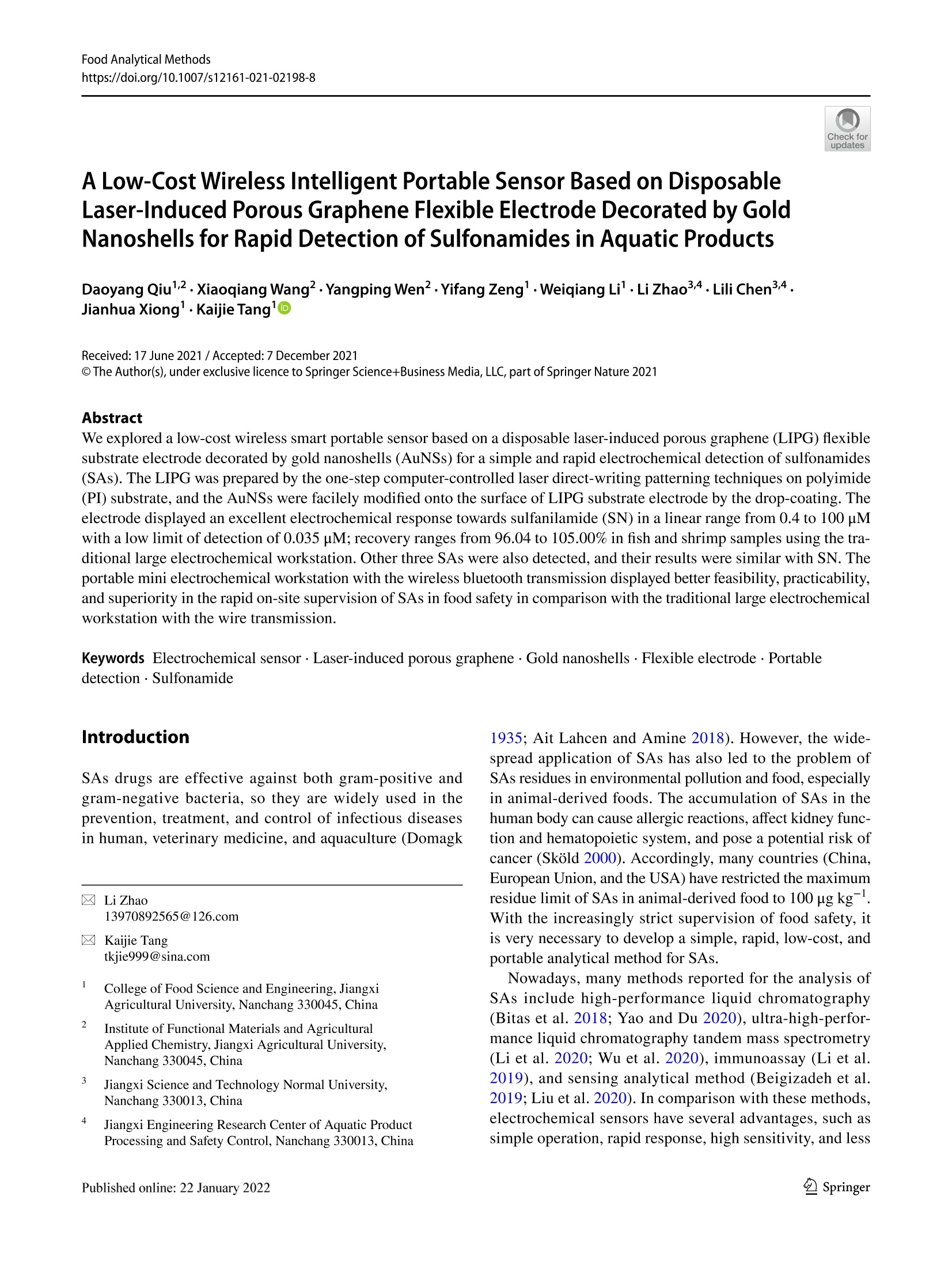

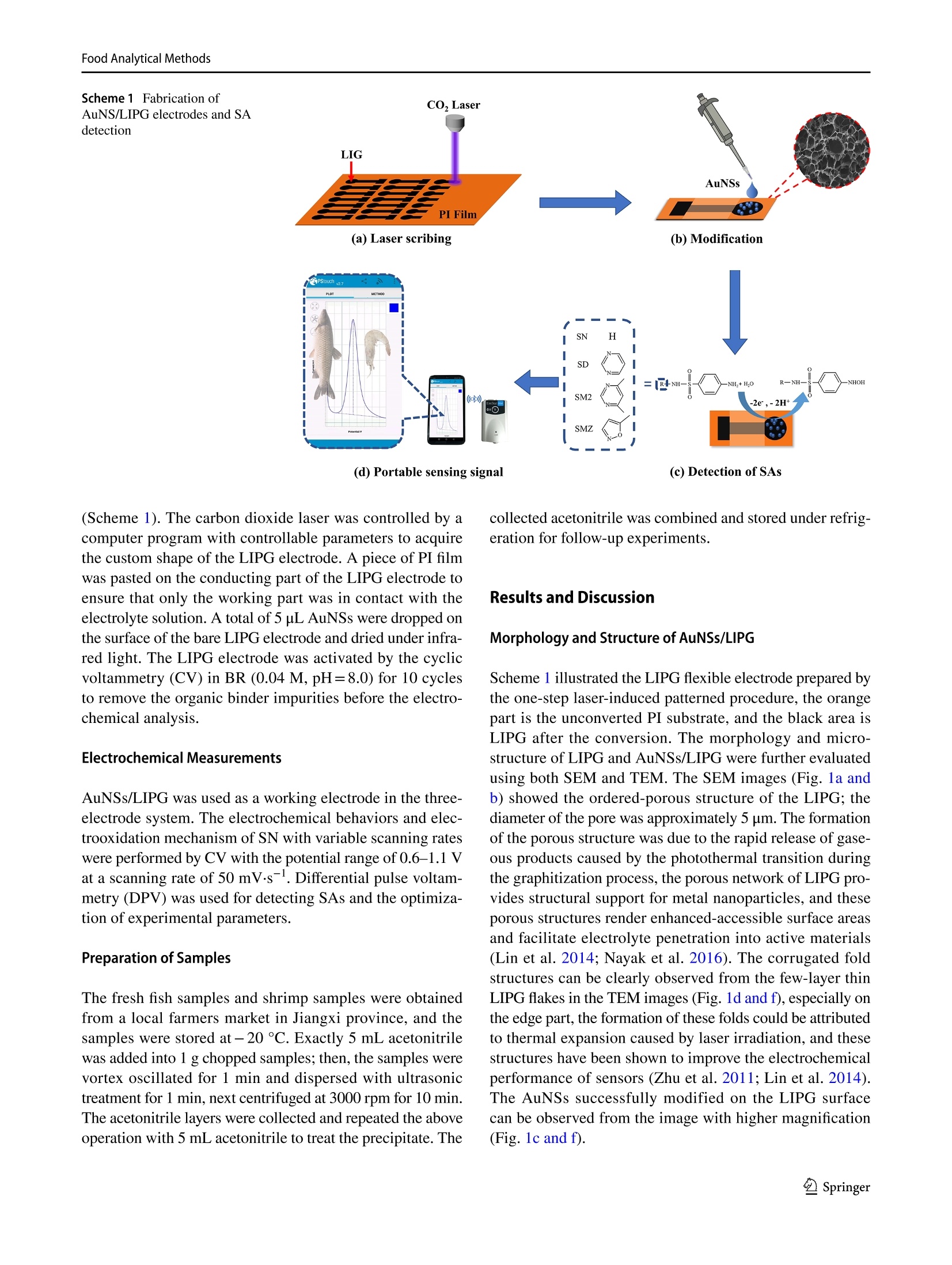
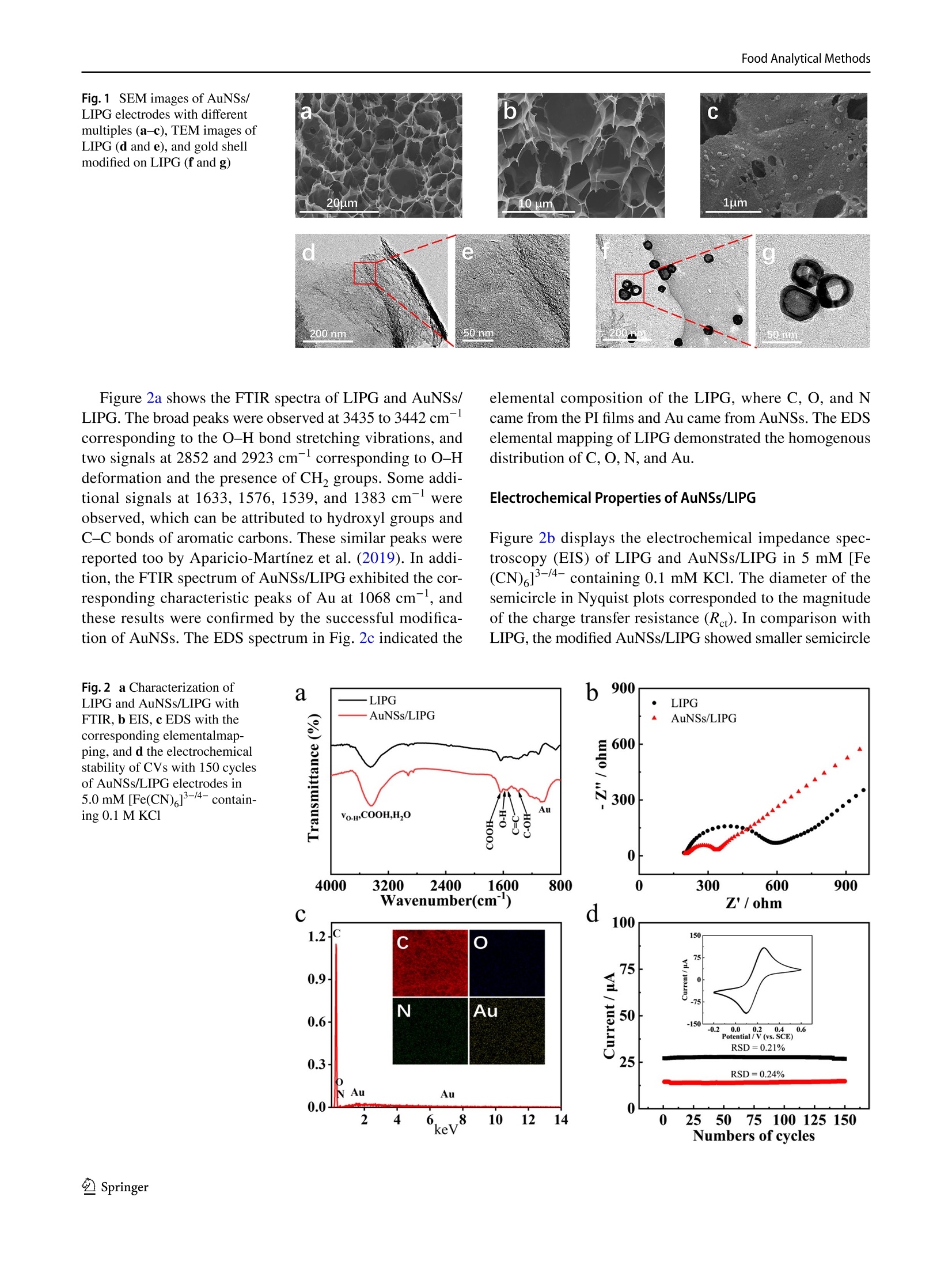
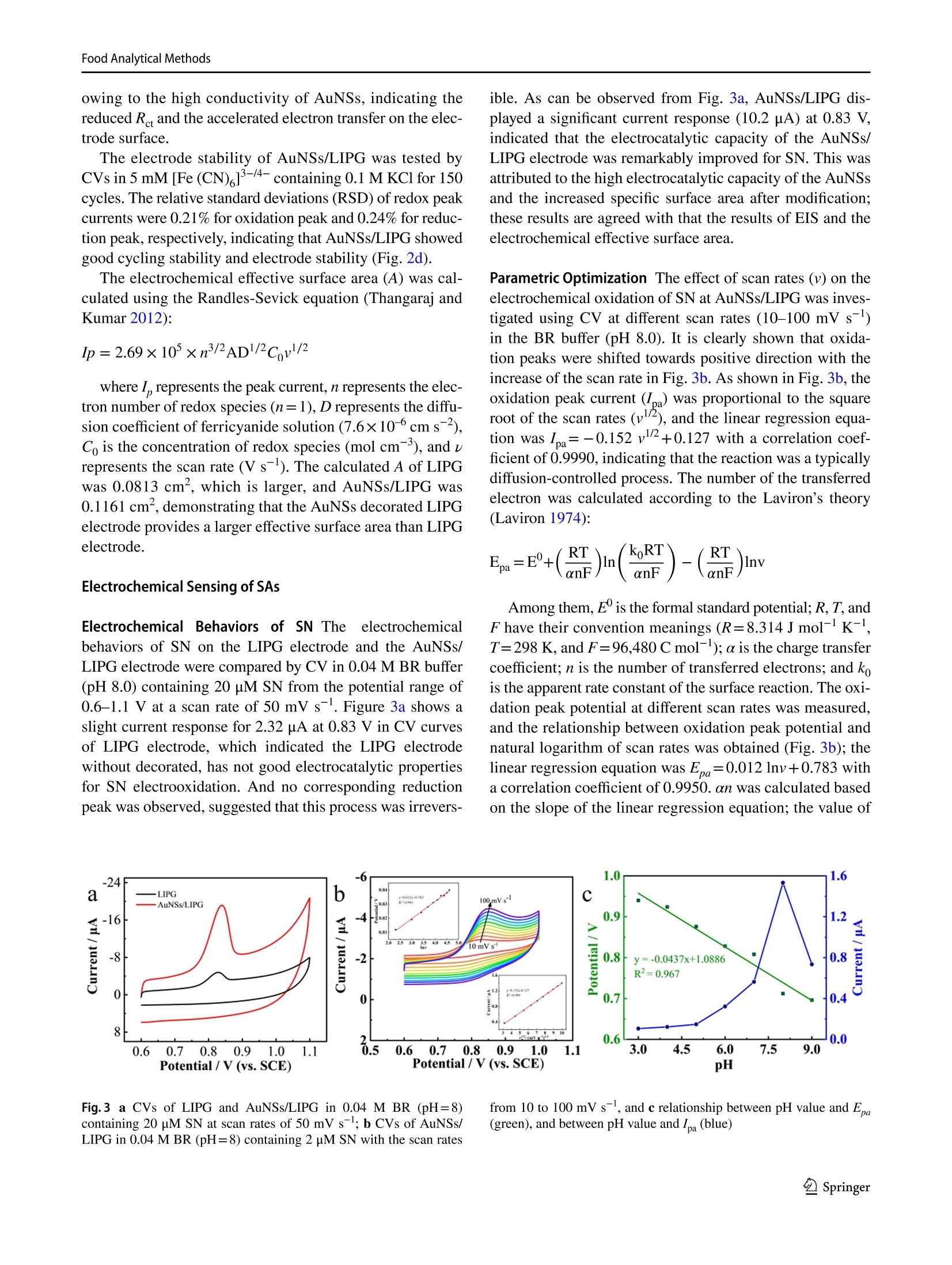



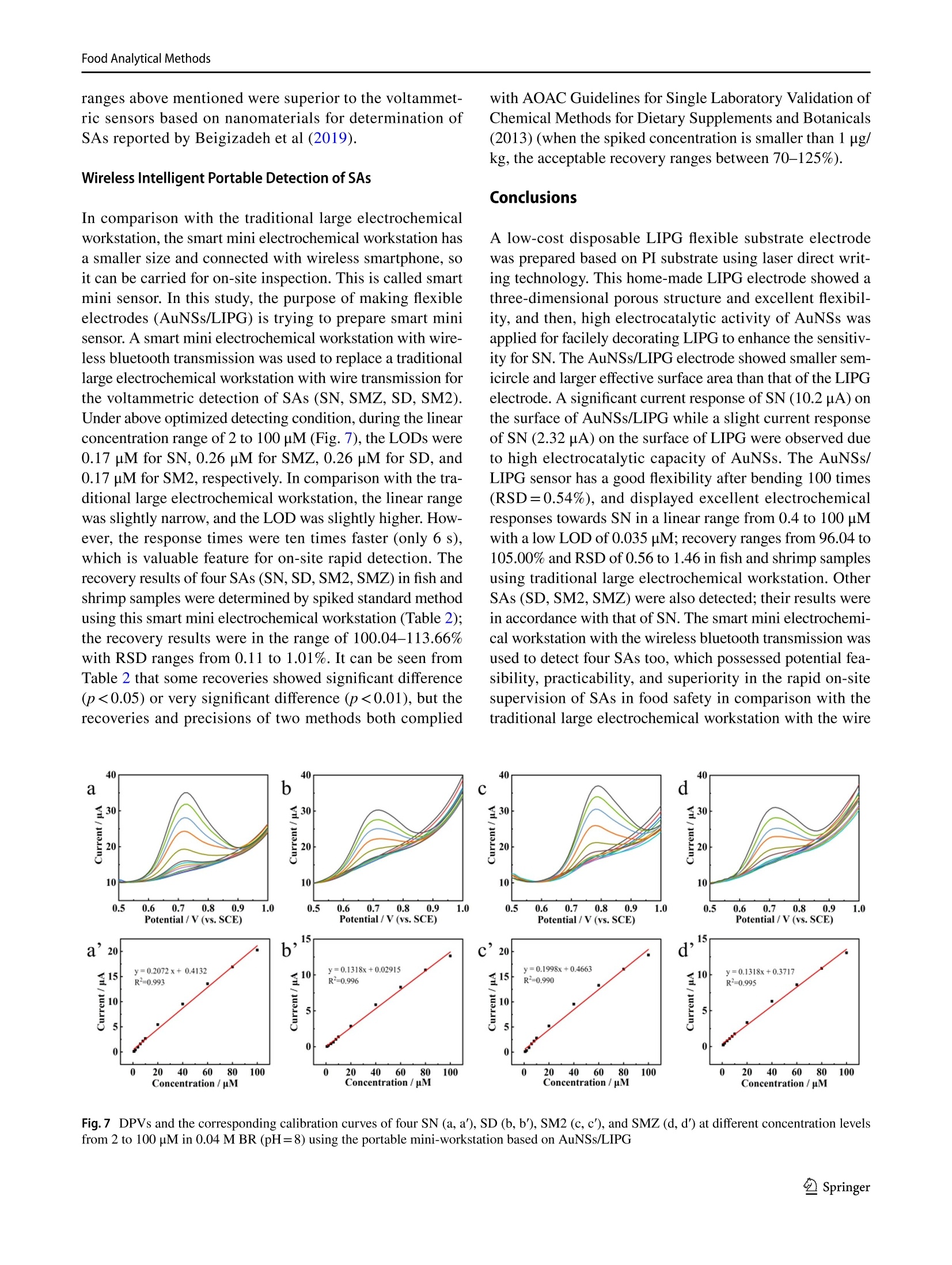
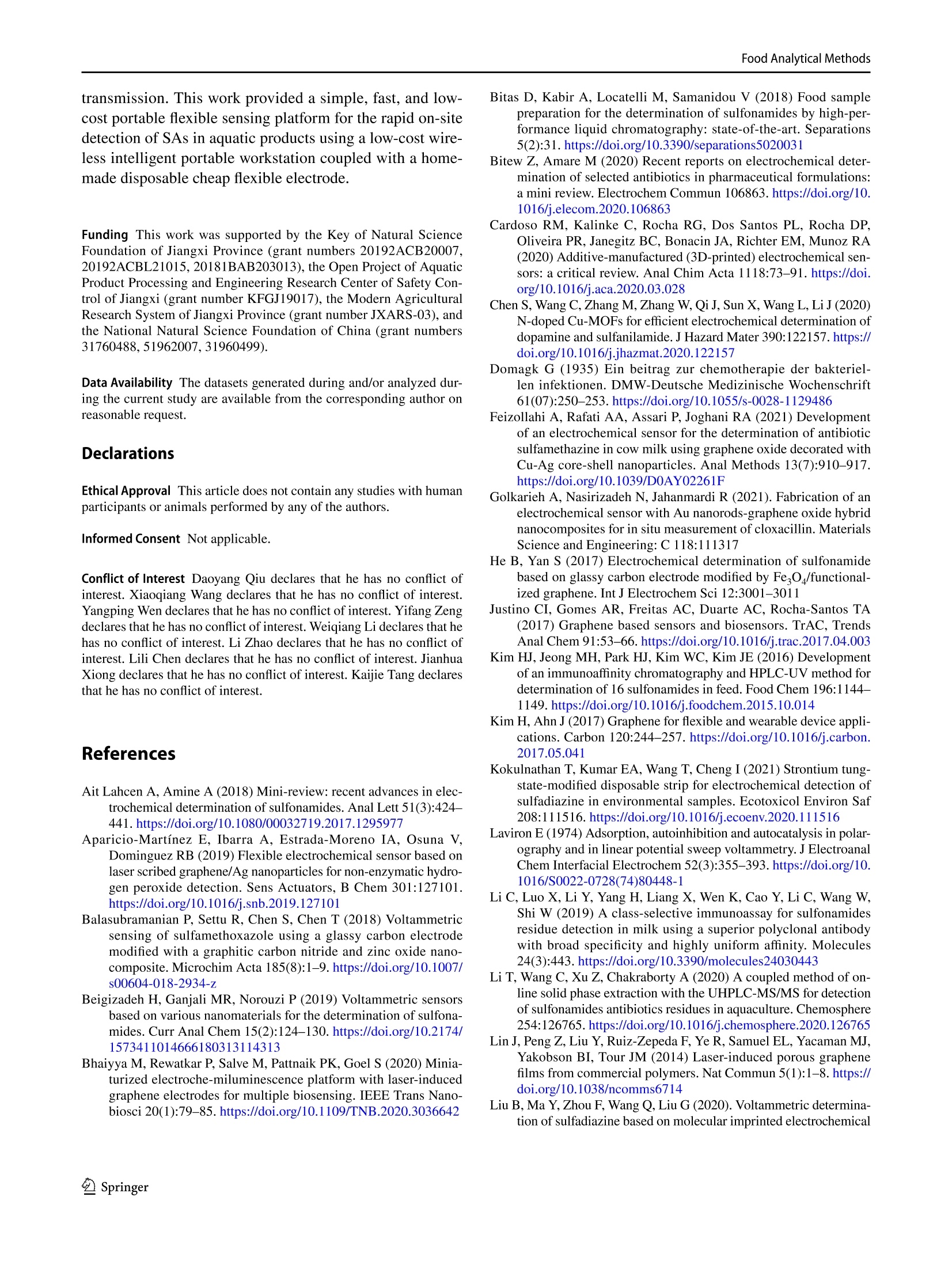

还剩9页未读,是否继续阅读?
雷迪美特中国有限公司为您提供《【EmStat3Blue电化学应用】无线智能便携式石墨烯柔性传感器,应用于快速检测水产品中的磺胺类》,该方案主要用于水产品中兽药残留检测,参考标准--,《【EmStat3Blue电化学应用】无线智能便携式石墨烯柔性传感器,应用于快速检测水产品中的磺胺类》用到的仪器有EmStat4X便携式电化学分析仪
推荐专场
相关方案
更多

